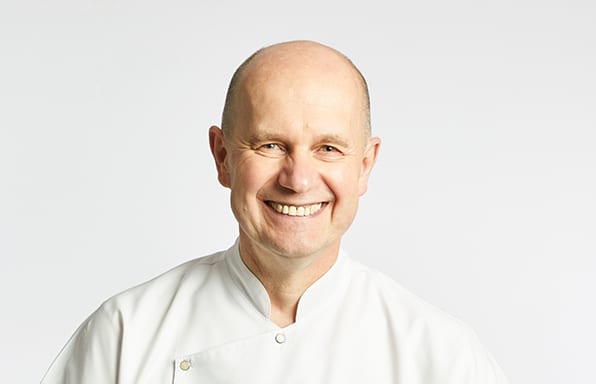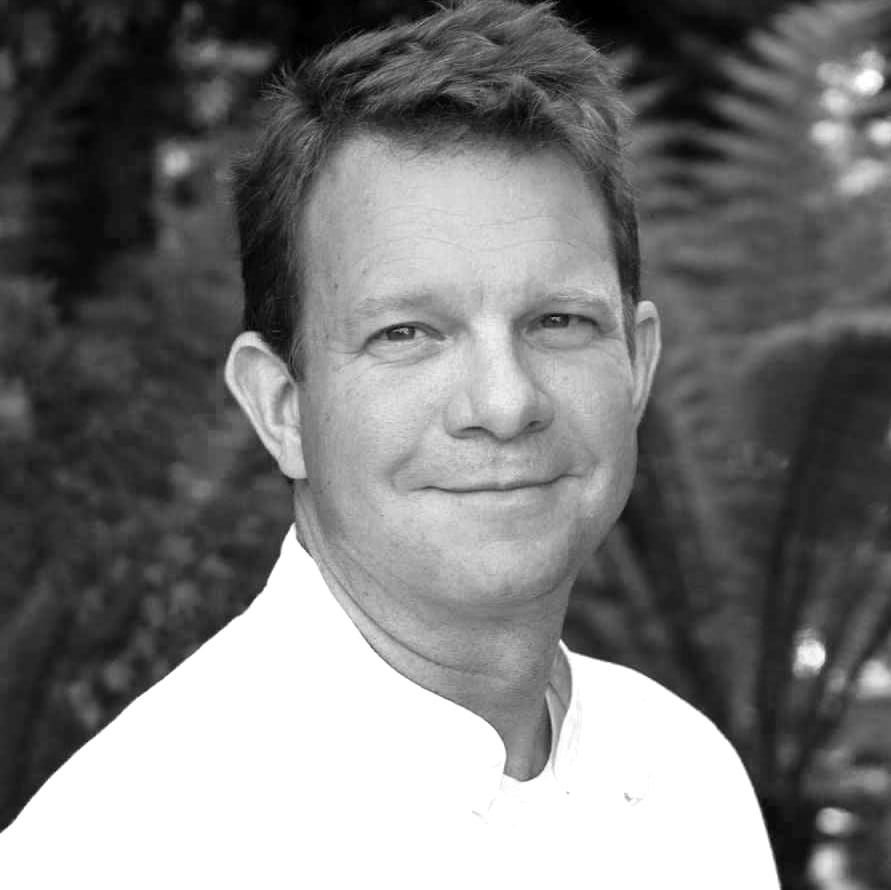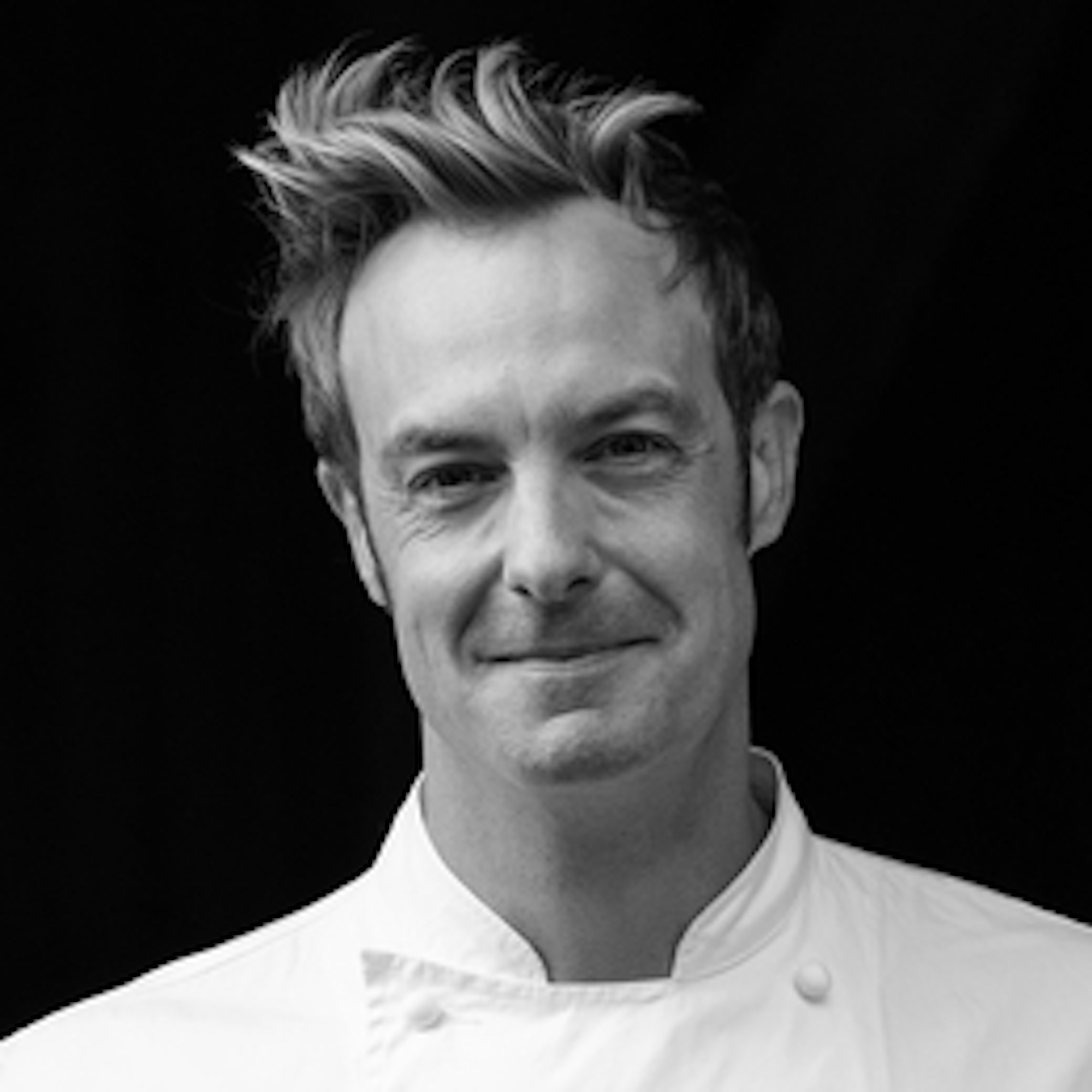French Vanilla Ice Cream with Raspberry Coulis
Step 1: Prepare the Ingredients
As Needed Ice
As Needed Water
1 vanilla bean or 10 g vanilla bean or paste
750 g Whole milk, 3.5% fat
250 g Sour cream or crème fraiche
150 g Granulated sugar
50 g Honey, light and fluid
200 g Egg yolks
To begin, scale all of the ingredients precisely.
Place ice inside a large bowl and add some water to make an ice bath. Insert a smaller bowl and set aside.
Step 2: Prepare the Ice Cream Base
Carefully slice the vanilla bean along the side using a paring knife. Then slide the flat side of the knife along the bean to release the seeds and set aside. Place the milk, vanilla bean and seeds, sour cream, sugar, honey, and egg yolks into a saucepan on low heat. Whisk to incorporate the ingredients.
Increase to medium heat constantly stirring until nappé consistency or it coats the back of a spoon and reaches 180ºF (82ºC) using a spatula.
Pour the mixture into the bowl in ice and cool it very quickly to 40ºF (4.5ºC) while stirring every few minutes. Remove it from the ice bath and transfer into containers. Place them in the refrigerator and let them mature preferably overnight.
Step 3: Scaling the Raspberry Coulis
5 g Gelatin sheets (160 or 170 bloom) or 5 g gelatin powder
25 g Water, pure bottled or filtered, cold to bloom gelatin
125 g Raspberry purée, or other crushed and strained berry puree (defrosted, if frozen)
4 g Lemon juice, or 2 g of lime juice, organic preferred, freshly squeezed
40 g Granulated sugar
40 g Honey, light and fluid
26 g Kirsch, raspberry vodka, or 80 proof raspberry liqueur, optional
To begin, scale all of the ingredients for day 2 precisely.
Place the storage containers in the freezer for later use.
Step 4: Prepare the Raspberry Coulis
Bloom the gelatin in a bowl using cold water and set aside.
Whisk the raspberry purée, sugar and lemon juice in a saucepan on medium heat. Adding the sugar and lemon juice to the purée right away will help preserve the color. When it simmers, add the bloomed gelatin. Allow it to simmer for a few minutes then turn off the heat. Add the honey. Remove the saucepan from the heat. When it reaches 85ºF (30ºC) add the alcohol. Transfer to a bowl and allow it to cool to room temperature.
Step 5: Assemble
Homogenize the ice cream base using an immersion blender. Strain the mixture and pour into the ice cream maker. Churn it until it is a creamy and smooth consistency.
Remove the ice cream. Place a small amount of the raspberry coulis in each container. Then spoon in some ice cream pressing into the coulis. Alternate between the remaining coulis and ice cream. Freeze until ready to serve.
Storage: Store French vanilla ice cream with raspberry coulis in a glass or airtight food-safe container in the freezer for up to 1 month.
Notes
If using powdered gelatin, we recommend that you first place the cold water in a small bowl. Sprinkle the gelatin powder into the water while whisking it at the same time. Turn the vanilla ice cream into pumpkin ice cream by adding 125g of roasted pumpkin to the mix’s milk + spices. Serve the ice cream in mini pumpkins.
Turn the vanilla ice cream into pumpkin ice cream by adding 125g of roasted pumpkin to the mix’s milk + spices. Serve the ice cream in mini pumpkins.
Classic Chouquettes
Step 1: Preparation
710 g Pâte à choux for chouquettes, prepared
1000 g Vanilla pastry cream custard
100 g Hazelnut paste, 100%, or Nutella, store- bought or other roasted nut paste
Prepare the pâte à choux batter, pastry cream and hazelnut paste.
To begin, scale all of the ingredients precisely and bring to room temperature.
Preheat the oven to 340ºF (170ºC).
Step 2: Chouquettes
15 g Unsalted European-style butter, 82% fat, for greasing baking tray
1 recipe Egg wash, prepared
250 g Sucre grain (pearl sugar) or other coarse sugar, optional
Lightly grease the baking trays with butter. Be sure to wipe off the excess with a paper towel. Mark 5 lines on the baking tray about 2 in (5 cm) apart. Set aside.
Fit a pastry bag with a pastry tip and fill with the prepared pâte à choux. Pipe rows of 1 ¼ inch diameter spheres on each baking tray. Be sure to stagger each to ensure proper baking.
Gently dab the “tail” of the pâte à choux with egg wash. Then completely egg wash each sphere and sprinkle the top with sugar. Slightly angle the tray and tap the excess sugar over parchment paper.
Step 3: Baking the Chouquettes
Bake at 340ºF (170ºC) for 15 min. Then reduce the oven temperature to 300ºF (150ºC) for 12-15 more min or until golden brown. Briefly open the oven door to allow the steam to escape. Then bake for 3 more min or until golden brown.
Transfer the puffs to a cooling rack and allow them to completely cool.
Step 4: Filling
1000 g Vanilla pastry cream custard, prepared (1.5 recipe)
Gently poke a hole on the bottom of each chouquette and set it aside.
Combine the pastry cream and hazelnut paste in a stand mixer bowl. Mix on medium speed then increase to high speed for about 1 min or until it is homogenized using the whisk attachment.
Transfer the cream to a pastry bag fitted with a pastry tip.
Pipe the filling into each Choquette.
Storage: It is best to completely cool baked puffs for about 30 minutes then immediately fill them.
We do not recommend refrigerating unfilled puffs as they get soggy. Freeze unfilled puffs wrapped in plastic or in an airtight container for up to 1 month. To defrost, place them on a baking tray lined with parchment paper and allow them to come to room temperature. Flash bake in a preheated 400°F (204°C) oven for about 2 minutes. Let cool for about 15 minutes and use as directed.
Filled puffs only last for about 12 hours in a refrigerator then the cream makes the puffs soggy. We do not recommend freezing-filled puffs.
Traditional Brioche
Step 1: Preparing the Poolish-Yeasted Starter
95 g Whole milk, 3.5% fat, cold
10 g Dry instant yeast or 25 g fresh yeast
5 g Granulated sugar
70 g Pastry flour or all-purpose flour
To begin, scale the ingredients for the poolish-yeasted starter precisely and bring them to room temperature.
Calculate and adjust the temperature of the milk to the required base temperature of 54˚C.
Combine the milk, yeast, and sugar in a stand mixer bowl using a whisk. Then cover with flour. Allow it to ferment undisturbed at room temperature for approximately 30 min or until cracks appear on the surface.
You will now have the 180 grams of Total Poolish Starter for the next step.
Step 2: Mixing the Final Dough
180 g Poolish starter
410 g Bread flour
10 g Fine sea salt or fine table salt
45 g Granulated sugar
265 g Whole eggs, cold
240 g Unsalted European-style butter, 82% fat, 1 in (2.5 cm) cubes, room temperature
To begin the final dough, add the bread flour, salt, sugar, and eggs to the poolish. Mix on low speed for 2 minutes or until incorporated using the hook attachment.
Scrape the bowl and increase to medium speed. Mix for 10 to 12 minutes, or until the dough pulls away from the bowl. This will make a “slapping” sound.
Test the gluten window. Scrape the bowl and hook. Add the butter in small additions on low speed. Fully incorporate after each addition and occasionally scrape the bowl. Increase to medium speed and mix for 7-10 minutes. The final temperature of the dough should be 73-77˚F (23-25˚C).
Dust the work surface and beat the dough on the work surface until smooth. Lightly dust a bowl with flour, then transfer the dough. Cover and allow it to ferment at room temperature for 1 hour, 15 minutes to 1 hour, 30 minutes, or until doubled in volume.
Lightly dust the dough and work the surface. Turn out the dough. Bring the corners to the center and press out the gases. Then return it to the bowl. Cover and allow the dough to rest in the refrigerator overnight.
Step 3: Shaping and Proofing the Dough
1 recipe - Egg wash, prepared
50 g Bread flour for dusting
100 g Sucre grain (pearl sugar #6) or other coarse sugar, optional
The next day, apply butter to the loaf pans and set aside.
Lightly dust the dough and work surface with flour. Gently flatten the dough with your palm and cut the dough into three 370 gram pieces.
Round each by placing your thumb in the center. Take one corner and bring it over your thumb. Remove your thumb and press the center of the dough to secure. A new corner will form. Take the new corner and place that over your thumb in the center. Remove your thumb and press the center to secure. Repeat until the dough is a complete round. Turn over, making sure the smooth side is up, cup with one hand on each side and round it until it becomes a smooth ball. Slightly reshape it into a 51⁄2 in (14 cm) cylinder. Insert it into the loaf pans with the seam side down and tuck in the edges using the tip of a spatula. Place onto a baking tray.
Step 4: 2nd Egg Wash & Baking the Brioche
Prepare the proof box and set between 77-80ºF (25-26ºC).
Egg wash each loaf. Proof for 2 hrs, 30 min or until it doubles in volume.
Remove from the proof box and rest for 5-7 min at room temperature.
Step 5: Bake the Dough
Preheat oven to 320ºF (160ºC). Egg wash for a second time and sprinkle with pearl sugar.
Bake for approximately 20 min. Briefly open the oven door to allow the steam to escape. Then bake for about another 3-5 min.
Set on a cooling rack for about 5 min before removing them from the pans.
Step 6: Storage
Bake and cool brioche completely for at least 30 minutes. Place it in a linen or cloth bag at room temperature for about 24 to 48 hours. We do not recommend refrigerating bread as it dries out or eventually molds. Freeze tightly wrapped in plastic or place in an airtight container for up to 1 month. To defrost, frozen, baked brioche, place it wrapped in the refrigerator overnight or at room temperature for 2 hours. Unwrap and flash bake in a preheated 400°F (200°C) oven for about 2 minutes. We do not recommend refrigerating bread as it dries out or eventually molds.




